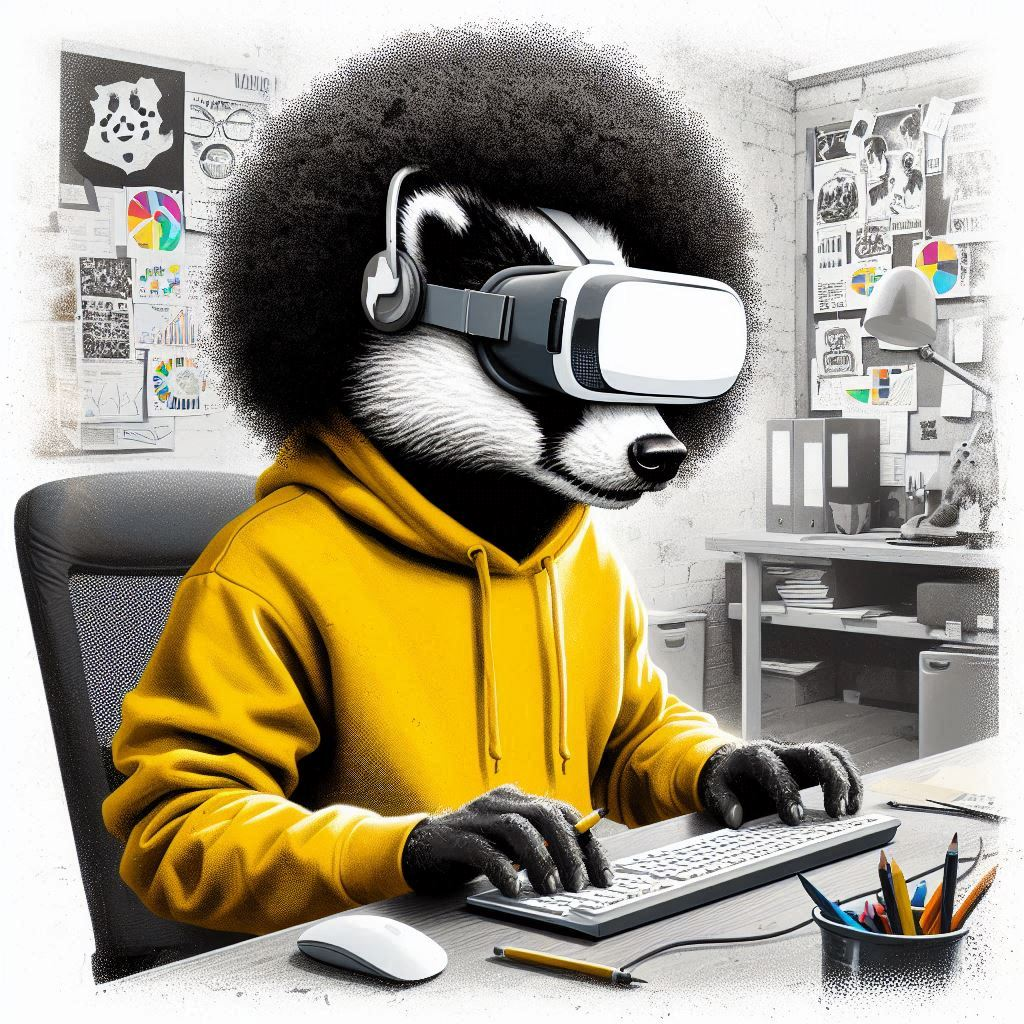Apple’s launch of the Vision Pro promises a world of spatial computing. Have you ever wondered if working in VR can be a reality?
I may not have £3,500 to test Apple’s vision (pun intended), but I have owned several headsets over the years and recently clocked up 600+ working hours in Virtual/Mixed Reality, allowing me to share some insights into this future of working.
Intrigued by the potential of colour pass-through and higher fidelity, I decided to upgrade from using my son’s Quest 2 to my very own Quest 3 in late November 2023, and quickly begin to integrate the headset into my work life.

As I explored different applications to work within, I found Immersed to be the one that ticked most of the requirements and with the least friction.
Founded in 2017 by Renji Bijoy, Immersed developed a multi-platform, collaborative virtual working environment. Starting their journey in VR, they have since adapted their app to accommodate a mixed-reality landscape.
At present Immersed supports Meta Quest 3, Quest 2, Quest Pro, HTC Vive Focus 3, Pico 4 and very recently Apple Vision Pro. Immersed also have their own headset in the works – Visor. While this headset is available for pre-order and set to ship sometime in September 2024, there is a lot of apprehension around the lack of prototype or physical demonstrations for such an imminent headset.
Immersed states their community is currently over 29,000 strong. Of which, I see those numbers increasing as more people experience VR for the first time.
If you came here wondering if you should try Immersed then the simple answer is yes! Enjoy. If you want to know some more about its features and my user experience, then please read on.
Setup
I recommend starting your setup on the PC/Mac/Ubuntu device you want to link with your headset and head on over to immersed.com. From there you can register your Immersed account using an email address or via sign-on integration. It supports Google, Facebook, Apple and even LinkedIn. Once registered, download and install the agent software on your device. If your on a Corporate machine, make sure you have permission from your company and admin privileges. Once installed log into the agent and you are done.
Now jump over to your headset, install Immersed, log in and you should automatically be connected to your computer.
User controls & Interface
My morning routine consists of unlocking my laptop, putting on my Quest 3 headset, launching Immersed and starting work – all without needing to pick up a single VR controller, thanks to the Quest’s hand-tracking support.
The elimination of controllers from my daily setup reduces a ton of friction. From finding them, to using them, to them cluttering my desk. Controllers have no place in a modern office space.
While the Quest 3’s hand-tracking is good; it is not perfect. There are times when I struggle to reposition a screen or select a menu setting; leaving me frantically pressing the air, all of which can be rather frustrating. However, most of the time your jacked in you will be using your computers keyboard and mouse, so the daily use of hand-tracking is fairly minimal. For me it is a balance between friction and accuracy and I will happily take a reduction in accuracy against the friction of physical controllers while working.
Layered on top of the hand tracking is the unique shortcut menu. Viewing down at the palm of my hand reveals a circular menu button displaying time, headsets battery status and current duration. Pressing the big virtual button will show/hide the main menu, while the smaller buttons around the outside are used to toggle quick settings:-

- Show/Hide screen
- Immersed Mode
- Mute/unmute
- Change seating
Immersed’s main menu is a a basic square design where you can select computers, change your environments and tweak settings from tabs running down the left side and across the bottom. This menu can be dragged and repositioned wherever you want. All menus support interaction via controllers, point-and-pinch as well as touch.
I’ll give you hand gestures!
Before I continue, I must talk about my favourite Immersed feature. By connect your thumb with your ring finger to toggle hand tracking on and off. Simples! It may not sound like much, but the creation of this gesture is a spot of genius. Not just in the app, but VR in general.
Meta! For the love of VR! Please take note and add this gesture to your next OS update.
Try any form of physical and virtual multitasking in mixed reality and you will soon experience the problem. If I watch a movie in pass-through while enjoying some chow. I can’t go 5 minutes without hand tracking accidentally jumping the movie forward or resizing the screen. This causing me to restrain my hand movements and eat food like I have T-Rex arms.
Meta! For the love of VR! Please take note and add this gesture to your next OS update. It’s a feature that should be available for every application that supports hand tracking.
Screens, Screens everywhere
Out of the box you can have 3 virtual monitors with resolution from 720p to near 1080p in landscape or portrait orientation. Once you have a pro subscription, you can increase the count to 5 and crank the displays all the way to 4k. Don’t expect to run all your monitors at 4k without some hardcore CPU/GPU in your computer.
It is worth noting that your laptop/PC/Mac monitor is fixed to its physical pixel limitations. Therefore, a 1080p monitor cannot go any higher within the Immersed settings. But you can work around this limitation by enabling upscaling/super resolution from the Nvidia GeForce or AMD Radeon toolsets.
All screens can be freely moved, resized, tilted, and curved. By default Immersed does have training wheels in place for monitor positioning and I recommend that you instantly turn off “Snap to grid” and “Auto Rotate” within the quick options to make the most of your screen layout.
You move your screens by grabbing the their top handle using the pinch gesture. While your thumb and index are pinched, moving your hand moves the position, while moving your wrist sets the pitch and tilt of the display. This allows for bespoke screen arrangements via an intuitive control scheme.
My virtual workspace comprises of 4 screens.

Display 1 is around 28” and positioned central, but in a way that would be through my desk (in reality) and tilted back.
Display 2 is a similar size and floats above the primary; tilting forward to allow for natural head movement.
Display 3 is in portrait mode, positioned to the left with my calendar on display. Portrait displays are also perfect for email or chat apps like teams, slack, discord etc.
Display 4 My final sits in landscape to the right and is used for extra items or apps I may use.
It amazes me how many developers do not design their apps to allow free positioning of virtual screens. Most implement a curved panoramic display arrangement which looks cool at first glance, but soon becomes apparent how unrealistic a layout like that is for real world usage. Devs need to remember that the reason for being in a virtual environment is to break through the walls of reality and the rigidity of traditional monitor setups.
Pass-through and portals
My first experience of Immersed was back in 2022 on Meta Quest 2. And the main reason I stopped was Meta’s dog-with-cataracts excuse for pass-through. Within the Quest 2 I could not identify keyboard keys, see my phone or computer screen. Causing me to constantly take my headset on and off. Not exactly what I would call immersive.
Since then Immersed has played the long game with pass-through. While they waited for cameras to improve they laid the foundation to a unique pass-through experience that enables a blend of mixed and virtual realities. Now In glorious Technicolor, keyboard pass-through on Quest 3 is amazing. And while some apps only offer a small window to your keyboard – Yes Horizon Workplaces, I’m looking at you! In Immersed you can customize it to reveal the whole width of your desk.
Immersed seam to understand that your physical desk is just as much a part of your working environment as your virtual displays. Due to this consideration, I can not only see my keyboard and mouse, but my phone, notebook, and navigate around any other rubbish that has accumulated on my desk.
In addition to keyboard pass-through you can add up to five pass-through portals. These portals provide extra windows to the real world that can be placed anywhere in your 360 degree virtual environment. Each portal can be set as wide rectangle, sphere, or cube of any size. Once set each portal becomes a permanent addition that can be toggled on or off from the menu.
To me, these portals provide a middle ground between total VR and complete pass-through. Allowing me to locate my morning coffee while I sit in my virtual Parisian café. I also place a portal behind me to expose my window – which may sound strange. But while working in a virtual café or on a sunset mountain top. You can easily loose you bearing on the real world outside. This portal allows me to quickly check-in with the real world weather or anything else going on outside my house at a glance.
3D Environments
Immersed is not unique with offering virtual environments, but the quality and variety of environments available is commendable. There are currently 21 environments available. Ranging from a down-to-earth coffee shop to a spaceship orbiting a rotating earth.
Each environment comes with its own ambient soundtrack – that can be controlled in the settings. There are even trippy visualization environments that move in unison to a pre-set soundtrack. The later offerings are a bit much for my brain to handle.
The level of detail shows that these environments are built with passion and some even include animated features, like parrots flying overhead, ceiling fans rotating or wall clocks ticking in synchronicity with your system clock. All of which adds some life to each environment.
Streaks and Credits
Immersed have implemented a unique gratuity scheme that I have not seen before. They reward based on the frequency of app usage. Use Immersed for 3 days within a 10-day period and you will unlock the pro tier features, such as more screens and higher resolution. All for Free!!. Break the streak and the features are revoked until the streak is regenerated.
This reward scheme enabled a frugal me to sample all features for several months before I decided to become an official subscriber to the app.
I applaud the idea of rewarding a users dedication. It helps casual users integrate VR into their working environment and helps build a community; all without adding financial commitments on the users. Once people are hooked and use it daily (like me) it becomes a no brainer to pay the $4.99 a month subscription. Told you I was frugal!
The now and the future
Let me wrap up this post by saying that the future of VR productivity is here and it is only getting better. Would I recommend it for everyone? No. The VR industry still has several barriers that need to be addressed before there is anywhere near mass adoption. The fact that this is tried and tested (with all its imperfections) way of working is a wonder to behold. So if you have a passion for VR and the patience to report issues, give feedback and help support the industry then I know you would embrace the opportunity to work in a childhood sci-fi fantasy.


Leave a Reply